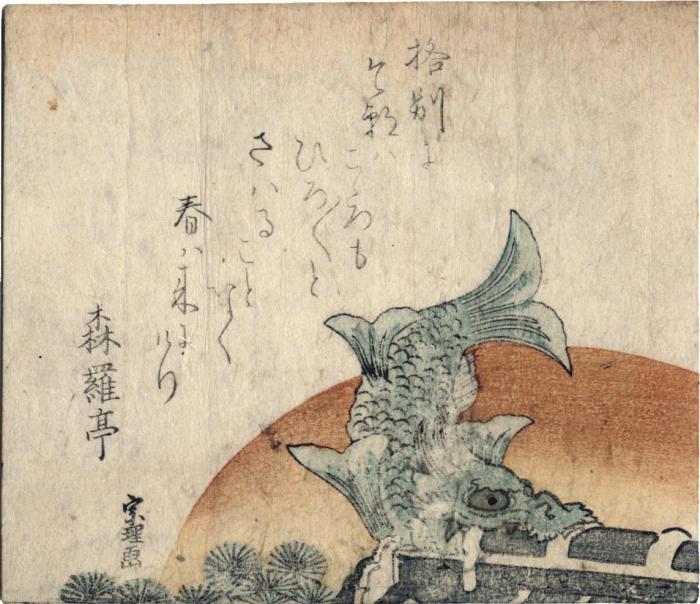Katsushika Hokusai (葛飾北斎) (artist 1760 – 1849)
The dolphin-like kinshachi (金鯱) atop Nagoya Castle at sunset (or sunrise)
ca 1790 – 1810
5.75 in x 5 in (Overall dimensions) Japanese woodblock print
Signed: Sōri ga (宗理画)
British Museum - Hiroshige II print of the kinshachi
Nagoya Castle kinshachi information - in Japanese only Sōri is one of Hokusai's early names used in the 1790s. At the end of 1794 he changed his name from Shunrō (春郎) to Sōri. In the spring of 1798 he changed it again, but this time to Hokusai Tokimasa.
****
In the Kodansha Encyclopedia of Japan (vol. 5, p. 309) it says of Nagoya Castle that "The five-storied donjon was destroyed during World War II, but its exterior has since been reconstructed. Also reconstructed were replicas of its pair of famous golden shachi (dolphinlike sea creatures), almost 3 meters (10 ft.) high and covered with gold scales, which now decorate the gable roof ends of the new ferroconcrete main keep."
This creature was placed on other rooftops, but this particular golden one is called the kinshachi (金鯱 or きんしゃち).
Many dictionaries refer to this kanji character as a shachihoko (しゃちほこ) or "fabulous dolphin-like fish". Jim Breen gives it as 鯱鉾 a "mythical carp with the head of a lion and the body of a fish" which is an auspicious symbol of protection and well-being.
A large kinshachi was displayed at the Vienna International Exhibition in 1873 and proved to be an enormous success. (Source: Modern Japanese Art and the Meiji State: The Politics of Beauty by Doshin Sato, p. 111.
This information is taken directly from printsofjapan.com.
****
". Several Japanese castles were adorned with these animals in feudal times because it was believed that they had the ability to make it rain, and they would protect the castle if a fire started..."
Quoted from: "Symbolic Urban Spaces and the Political Economy of Local Collective Memory: A comparison of Hiroshima and Nagoya, Japan" in the Journal of Political and Military Sociology, Winter, 2003, p. 258.
surimono - 摺物 (genre)
